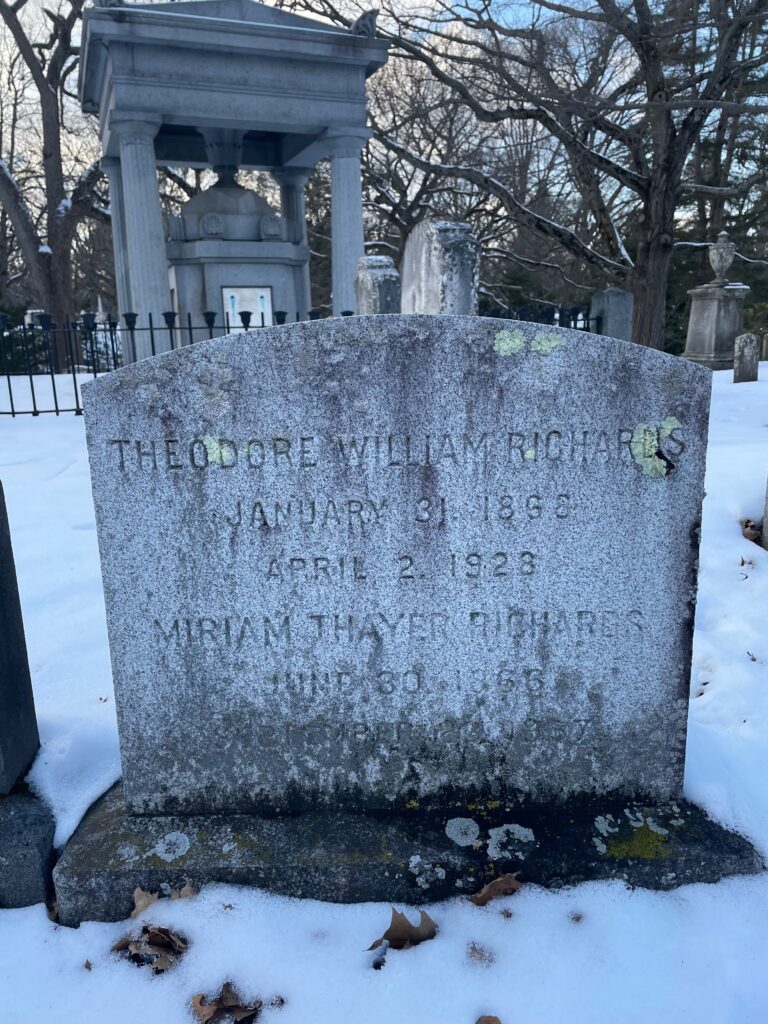Erik Visits an American Grave, Part 1,996
This is the grave of Theodore Richards.

Born in 1868 in Germantown, Pennsylvania, Richards grew up wealthy. His father was William Trost Richards, who was associated with the Hudson River School and pre-Raphalite painting scenes. His mother was Anna Matlack Richards, who was a poet and children’s writer and known for writing an Alice in Wonderland ripoff called A New Alice in the Old Wonderland, in case you were wondering how much of a ripoff it was. Theodore would have a very different side of intelligence than his parents, but what really matters is access to money. His parents vacationed with other rich people in Newport, Rhode Island and so he met when young the scientist Josiah Parsons Cooke, who had a telescope with him. The older man showed the kid Saturn’s rings and this sparked a lifelong love of science in Richards.
The family spent the late 1870s in Europe and then Richards started at Haverford College in 1883, still only 14 years old upon matriculation. He earned a bachelor’s degree there in 1885 and then started at Harvard the next year for another bachelor’s degree. He stayed on for his Ph.D. there, working on the atomic weight of oxygen. His old friend Cooke directed the dissertation. Then Richards went to Germany to work with Victor Meyer. He came back to Harvard and stayed there for the rest of his career.
I do not really have the ability to describe issues around chemistry research very effectively, but the short version is that Richards’ work on atomic weights was really important. He was the first to show that the same element could have different atomic weights thanks to radioactive decay. This helped build the foundations of atomic science. Basically, he helped discover isotopes. His work also contributed to the creation of the Third Law of Thermodynamics. Richards also invented a bunch of stuff too, including a new form of the calorimeter and the nephelometer, which measures the concentration of suspended particles in a liquid or gas colloid, whatever that means.
All of this led to Richards receiving the Nobel Prize for Chemistry in 1914. He was the first American to win the award. Since I obviously don’t know what I am talking about on this subject, let me quote the Nobel website about Richards:
Richards also studied atomic and molecular volume and he formulated a hypothesis of compressible atoms. He carried out a series of measurements of compressibilities of many elements and compounds in support of his theory, developing, applying and testing new methods and techniques. He introduced the use of transition temperatures of pure hydrated salts as fixed points in the standardization of thermometers, and the fundamentals of adiabatic calorimetry were developed under his guidance. His researches are recorded in some three hundred technical papers published mainly in the Proceedings of the American Academy of Arts and Sciences, the Journal of the American Chemical Society and the publications of the Carnegie Institution of Washington.
Is “researches” a word when it is used in this way?
Richards died in 1928, at the age of 60.
Theodore Richards is buried in Mount Auburn Cemetery, Cambridge, Massachusetts.
If you would like this series to visit other Chemistry Nobel winners, you can donate to cover the required expenses here. Harold Clayton Urey, who won in 1934, is in Fairfield Center, Indiana and James Batcheller Sumner, who won in 1946, is in Canton, Massachusetts. Previous posts in this series are archived here and here.


